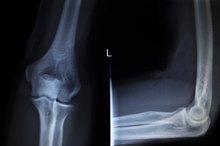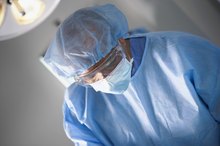Common Occurrences After Lumbar Spinal Fusion
Pain and instability in the vertebral joints of the lower spine cause many people to seek medical help. When conservative treatments such as medication, chiropractic adjustment or physical therapy fail to yield results, some may opt for surgery. Spinal fusion surgery involves the removal of the cartilaginous disc that separates two consecutive vertebrae. After the disc is removed, bone grafts are used to coax the two vertebrae to fuse into a single bony segment. The results of this procedure can vary.
If you are experiencing serious medical symptoms, seek emergency treatment immediately.
Failed Back Surgery Syndrome
At least 20 percent of all spinal fusion surgeries fail to relieve lower-back pain, according to Dr. John Sherman, an orthopedic surgeon writing for the website Spine-Health 3. This result is so common that it has been given the name “failed back surgery syndrome,” even though it isn’t actually a syndrome. The failure of surgery to relieve pain is most often an indicator that the lesion that was removed during the operation was not actually the cause of the pain in the first place.
Lengthy Recovery Time
Pros & Cons of Lumbar Spinal Fusion
Learn More
It takes time for bones to heal, and after a significant surgical procedure such as lumbar spinal fusion, a patient should expect a considerable period of convalescence. Sherman advises that a period of three months is necessary for the fusion to set and begin to mature. During this period, activities that might compromise the surgery must be restricted to ensure proper healing. Flexion, extension or rotation of the lower spine may place undue stress on the growing bones. Vigorous activities such as running should also be limited. Prepping for surgery should involve rearrangement of the patient’s living environment to minimize the need for excessive stretching and lifting during the recovery period.
- It takes time for bones to heal, and after a significant surgical procedure such as lumbar spinal fusion, a patient should expect a considerable period of convalescence.
Muscle Deconditioning
Following lumbar spinal fusion surgery, a patient must spend a certain amount of time resting so that the bones can heal. Unfortunately, this sedentary period can result in weakening and atrophy of the patient’s muscles due to lack of exercise.
The back muscles can also be injured during the procedure itself. Dr. Sang-Hyuk Min of the Department of Orthopedic Surgery at Dankook University in Korea notes that postoperative bed rest, the use of back braces and a program of activity modification may be the key elements influencing the health of the back muscles after spinal fusion surgery.
- Following lumbar spinal fusion surgery, a patient must spend a certain amount of time resting so that the bones can heal.
Related Articles
References
- "Asian Spine Journal"; The Quantitative Analysis of Back Muscle Degeneration After Posterior Lumbar Fusion: Comparison of Minimally Invasive and Conventional Open Surgery; Sang-Hyuk Min et al.: December 2009
- Spine-Health: Failed Back Surgery Syndrome (FBSS): What It Is and How to Avoid Pain After Surgery
- Spine-Health: Spine Fusion Post-Operative Care
- American Academy of Orthopaedic Surgeons: OrthoInfo. Spinal fusion. Updated June 2018.
- American Academy of Orthopaedic Surgeons: OrthoInfo. Spinal fusion glossary. Updated June 2018.
- U.S. National Library of Medicine: MedlinePlus. Spinal fusion. Updated April 9, 2020.
- U.S. National Library of Medicine: MedlinePlus. Spine surgery. Updated April 9, 2020.
- American College of Surgeons. Medication and surgery: before your operation. Updated May 2019.
- Shaw KA, Griffith MS, Shaw VM, Devine JG, Gloystein DM. Harvesting autogenous cancellous bone graft from the anterior iliac crest. JBJS Essent Surg Tech. 2018;8(3):e20. doi:10.2106/JBJS.ST.17.00068
- Mayo Clinic. Pain medications after surgery. Updated February 22, 2020.
- U.S. National Library of Medicine: MedlinePlus. Acetaminophen. Updated April 20, 2020.
Writer Bio
For 15 years, Charis Grey's award-winning work has appeared in film, television, newspapers, magazines and on the Internet. She has worked as a story editor on the CBS drama "Flashpoint" and her work appears bimonthly in "The Driver Magazine." She has a Bachelor of Science in biology and a doctorate in chiropractic medicine from Palmer College.









